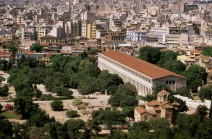 Athens is a big city, almost 4 million inhabitants counting the suburbs, practically a little more than one third of the entire Greek population. So it easy to imagine that the greatest percentage of crime is concentrated in the capital. Still, Athens is safer than other European big cities.
Athens is a big city, almost 4 million inhabitants counting the suburbs, practically a little more than one third of the entire Greek population. So it easy to imagine that the greatest percentage of crime is concentrated in the capital. Still, Athens is safer than other European big cities.
[sam id=”7″]
Enlarge Map
The peculiarity of Athens compared to other big cities I know, is that the most dangerous neighborhoods are located downtown (see map on the left), allowed to become ghettos of illegal immigrants, drug addicts with their drug dealers and homeless people. In principle, however, it remains a relatively ‘safe’ city. You may move around with public tranport and walking worry less all times of day or night, if you just avoid the ghetto areas of the center and following the usual precautions for travelers: do not look too ‘American tourist’ and leave the Rolex and diamonds in the safe box!
The greatest danger when walking around is to cross the road, we’re not at the levels of Cairo, but not far off. I am not exaggerating. The pedestrian is practically invisible, there are no traffic lights green to be trusted, the crosswalks are a joke, motorcycles and mopeds moving on roads and sidewalks practically following no rules. Watch out!
A separate story are the demonstrations and clashes with police. The news media have shown apocalyptic images of war and destruction. In fact in most of the, now rare cases, the field of combat is limited to the central Syndagma square and outside parliament and rarely extends more than 300 meters in radius. Where the effect of tear gas ends, life continues as normal. However, if you find yourself in the midst of a demonstration, change your way, especially if you see a lot of riot police squad or even worse, many cameras and photographers.
With your motorhome: If you are not in the mood for adventure, spare yourselves the bad experience of driving downtown. Especially since even if found to park, and it is not so impossible, the chances of finding a broken window on your return are quite high. My advice is to park in residential areas on the outskirts, in car parks or even free, but avoiding isolated areas, or opt for a campsite. If you, like us, are not fans of campsites, follow the classic method to evaluate the safety of the place you have found to park. Get off the car and take a ride walking nearby: if there are crystals of broken windows on the floor, empty bottles or cans of beer and wine nearby or weird signs and screeching on the asphalt … the message is clear!
Once you find your spot use public transport to move around and enjoy your visit.
[sam id=”7″]
 Athens is a big city, almost 4 million inhabitants counting the suburbs, practically a little more than one third of the entire Greek population. So it easy to imagine that the greatest percentage of crime is concentrated in the capital. Still, Athens is safer than other European big cities.
Athens is a big city, almost 4 million inhabitants counting the suburbs, practically a little more than one third of the entire Greek population. So it easy to imagine that the greatest percentage of crime is concentrated in the capital. Still, Athens is safer than other European big cities.